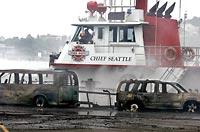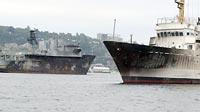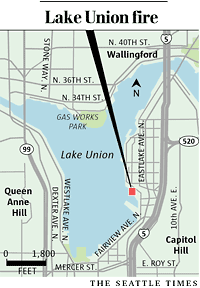Fire investigators seek cause of NOAA blaze

Investigators today will get their first waterside view of the damage caused by Wednesday's four-alarm fire that gutted two piers on South Lake Union.
Fire investigators from the Seattle Fire Department, Seattle police and the federal bureau of Alcohol, Tobacco, Firearms and Explosives (ATF) will take boats to examine the damage at the charred piers at the National Oceanic and Atmospheric Administration's (NOAA) Pacific Marine Operations Center at 1801 Fairview Ave. E. in hopes of determining a cause for the blaze, said fire spokeswoman Helen Fitzpatrick. It's routine for the fire department to ask police and ATF to help investigate large fires, she said.
Investigators have been interviewing witnesses even as firefighters continued to douse hot spots this morning, Fitzpatrick said. A track hoe was brought in to pull up the piers' decking so firefighters can attack hot spots.
"Nobody's getting out on the pier" today because it's not safe, she said.
Cpt. Mark Ablondi, NOAA's commanding officer for the Pacific Marine Operations Center, said it'll be a couple days before cleanup of the site can begin. Meanwhile, the 62 NOAA employees who worked out of the federal facility on Fairview Avenue East have relocated to NOAA's Sand Point Way offices.
Structural engineers will begin examining the NOAA buildings damaged in the blaze today but any inspection of the burned piers will "be a much longer process," he said.
"Hopefully by the weekend, we'll know a little more," Ablondi said. Right now, though, "the piers are unsound — we can't even walk on them."
The fire began around 1:20 a.m. Wednesday, about two and a half hours after the end of the annual Fourth of July fireworks display over Lake Union. In addition to the two large NOAA piers and two smaller piers, the fire damaged two decommissioned ships and burned two outbuildings. A damage estimate has not yet been calculated.
Dozens of residents from nearby houseboats were evacuated during the blaze.
Blair Robbins stood on the patio of her houseboat and watched orange flames jump from one wooden pier to another, coming within 100 yards of her boat dock on South Lake Union.
As the fast-moving fire pushed inland and dense, acrid smoke billowed into Seattle's Eastlake neighborhood, Robbins threw on some clothes, woke her husband, grabbed her purse and fled along with dozens of others who live on houseboats north of the National Oceanic and Atmospheric Administration (NOAA) facility at 1801 Fairview Ave. E.
"It was really frightening," said housebaot resident Blair Robbins, who watched the flames come within 100 yards of her boat dock on South Lake Union. "The fire just kept screaming along the dock toward the land."
The fire apparently started at the end of one of two NOAA piers, which jut about 500 and 600 feet into Lake Union. A couple of Seattle police department Harbor Patrol boats arrived within minutes, and officers "were madly pumping water onto the fire but they weren't even making a dent," Robbins said.
Seattle firefighters attempted to fight the blaze from the pier but were forced back to the lake's eastern shore when the wind suddenly changed, causing flames "to mushroom" to both the north and south, said Seattle Fire Chief Gregory Dean. The fire was fueled by flammable creosote, which was used to preserve the piers. It quickly raced north underneath the old pier, he said.
The fireboat Alki, which is docked at Fishermen's Terminal, joined the fire fight at 1:52 a.m., Dean said. A second fireboat, the Chief Seattle, was dispatched from Elliott Bay but took about three hours to get to the scene because an off-duty crew had to be called in before piloting the boat through the Ballard Locks, he said.
It took 100 Seattle firefighters, along with dozens more from several Eastside departments and the Coast Guard, until about 11 a.m. to get the stubborn blaze under control.
Two of five buildings on the 15-acre NOAA Pacific Marine Operations Center were destroyed and two large steel-hulled ships, the 175-foot McArthur I and the 224-foot Assertive, suffered heat damage to their starboard sides, said Ablondi.
"It's devastating," Ablondi said of the fire that will force NOAA officials to find alternate berths for four ocean-research vessels when they return to their Seattle homeport in the fall. It could be a couple of years before the piers are rebuilt, he said.
About 100 NOAA employees and their families watched the Fourth of July fireworks display over Lake Union on Tuesday night from the piers but all had left by 11 p.m., Ablondi said. Smoking and fireworks are prohibited on the government piers, he said.
Dean declined to comment on whether fireworks are thought to have sparked the blaze. "I hate to guess," he said. The Alki and Chief Seattle were both on Lake Union during the Fourth of July fireworks display, but had been sent back to their respective ports at midnight, he said.
Seattle police Harbor Patrol Sgt. Kevin Haistings said 23 officers — almost the entire harbor unit — had been on duty during the fireworks show but had returned to their station near Gas Works Park when the fire broke out. Three years ago, in response to public outrage over the Chief Seattle's lengthy response time to Lake Union blazes, Seattle Mayor Greg Nickels ordered the Alki moved to Fishermen's Terminal, where it could respond faster to fires on fresh water.
Nickels was pleased with how quickly police and firefighters responded to the NOAA fire, said Nickels' spokesman, Marty McOmber.
Two new fireboats are expected to be added to the Seattle Fire Department's fleet within the next year, he said.
Seattle voters approved a $167 million levy in 2003 after a series of marina fires on Lake Union sparked criticisms about the time it took for fireboats to make it through the Ballard locks to battle the blazes.
The 108-foot Leschi, with a pumping capacity of 20,000 gallons of water a minute, will arrive next year, McOmber said. A nearly 45-foot boat that has yet to be named will arrive this summer. Both will be moored at the department's Elliott Bay station.
When the new boats come online, the Chief Seattle, a 23 year-old boat, will be renovated and moved to the Lake Union waterfront; the nearly 80-year-old Alki will be retired, he said.
Seattle Times staff reporter Jennifer Sullivan contributed to this report.
Sara Jean Green: 206-515-5654



Lake Union fires![]()
![]()
Dec. 20, 1995 — Master boatbuilder Frank Prothero loses his boathouse on Lake Union to fire but saves the handcrafted 65-foot schooner Glory of the Seas.
May 28, 2001 — A dozen boats are destroyed at the Cadranell Yacht Landing marina on Fairview Avenue East.
Jan. 1, 2002 — Fifteen boats are destroyed and 10 others are damaged at the Seattle Yacht Club on Portage Bay.
May 17, 2002 — A fire at Seattle Marina near Gas Works Park destroys 31 boats and leaves at least seven families homeless. The fire prompts Seattle Mayor Greg Nickels to order the aging backup fireboat Alki to be moved from Elliott Bay to a slip at Fishermen's Terminal near Lake Union.
June 20, 2002 — A stubborn fire guts Wards Cove Packing, a metal fish-cannery storage building and machine shop at Fairview Avenue East and East Hamlin Street. The second-story storage area sustained most of the fire damage while the first-floor machine shop had smoke and water damage.
July 23, 2003 — Three pleasure boats are destroyed at the Seattle Marina, and the damage is estimated at $1 million.
Nov. 12, 2003 — A 40-foot sailboat caught fire in the 2400 block of Westlake Avenue North on the west side of Lake Union.
May 6, 2006 — An early morning fire causes about $300,000 damage to Ocean Alexander yacht sales office at the 1000 block of North Northlake Way.
Source: The Seattle Times archives